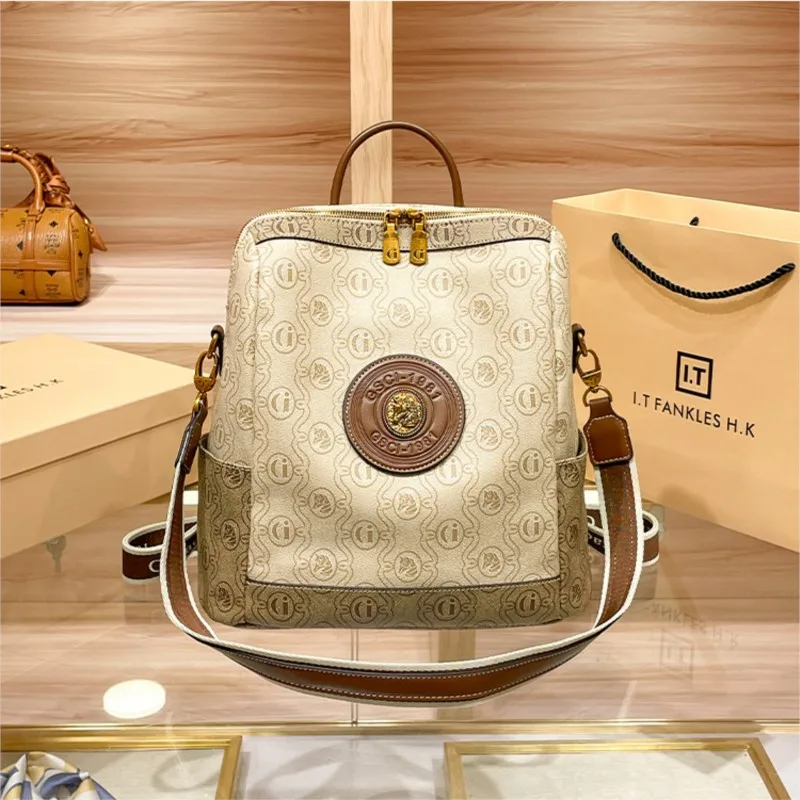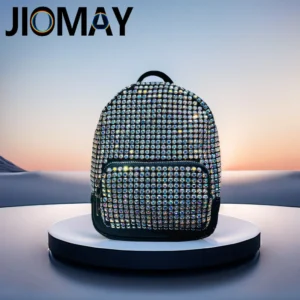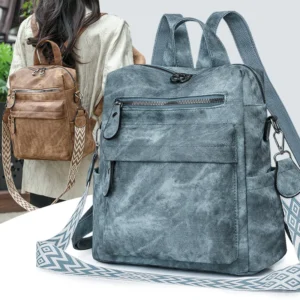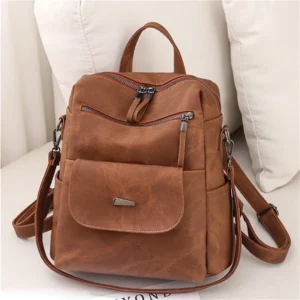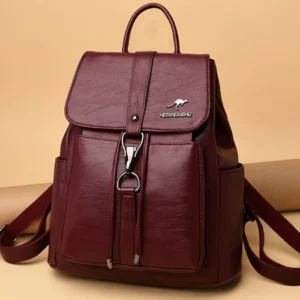Introduction to Women’s Leather Backpacks
In a world of disposable fashion, women’s leather backpacks stand apart as enduring companions that combine elegance with practicality. These versatile accessories represent more than just a way to carry your belongings—they’re investments that mature gracefully alongside you. Unlike synthetic alternatives that typically wear out within 1-2 years, a well-crafted leather backpack can faithfully serve you for a decade or more with proper care.
What makes these bags truly special is their remarkable ability to evolve over time. Premium leather develops a unique patina—a rich character that comes from daily use, telling the story of your adventures together. This natural aging process transforms an already beautiful accessory into something truly one-of-a-kind.
The perfect leather backpack balances artisanal craftsmanship with thoughtful design, offering both visual appeal and functional reliability. Throughout this guide, we’ll explore the essential design features that distinguish exceptional women’s leather backpacks from ordinary bags, helping you make an informed decision when investing in your next leather companion. From material quality to ergonomic considerations, we’ll cover everything you need to know about selecting a compact leather backpack for women that truly meets your needs.
Understanding Leather Quality and Types
The foundation of any exceptional leather backpack begins with the material itself. Leather quality directly determines how your backpack will look, feel, and perform over time, making it perhaps the most critical factor in your decision-making process.
The Leather Quality Hierarchy
Full-grain leather: The highest quality option, featuring the complete, unaltered top layer of the hide with all natural markings intact. Full-grain leather backpacks develop a beautiful patina over time and can last 10+ years with proper care. This leather is exceptionally durable and breathable, with each piece having unique natural textures and markings.
Top-grain leather: The second-highest quality, where the uppermost layer has been lightly sanded to remove imperfections. While still durable (typically lasting 5-8 years), it doesn’t develop the same rich character as full-grain but offers a more uniform appearance.
Genuine leather: Despite its misleading name, this represents a lower quality tier made from the layers remaining after top-grain has been removed. Less durable and typically lasting only 2-3 years.
Bonded leather: The lowest quality option, essentially leather scraps glued together with binders. These backpacks generally deteriorate within 1-2 years and don’t develop any meaningful patina.
Tanning Processes
The way leather is processed significantly impacts its properties:
Vegetable tanning: Uses natural plant tannins, creating leather that ages beautifully with a warm color that deepens over time. This traditional, environmentally friendly process yields a firmer leather that softens with use.
Chrome tanning: Employs chromium salts for a softer, more water-resistant leather available in various colors. This process is faster and less expensive, resulting in more pliable leather straight from production.
When examining leather quality, trust your senses. Quality leather has a distinctive natural smell, consistent grain patterns, and edges that reveal solid material rather than layered construction. The way leather feels in your hands—substantial without being stiff—can tell you much about its quality.
Craftsmanship: The Markers of Quality Construction
Even the finest leather can’t compensate for poor construction. Superior craftsmanship ensures your backpack maintains its beauty and functionality through years of daily use.
Stitching Excellence
Examine the stitching carefully—it should be tight, even, and without loose threads. Quality backpacks feature reinforced stitching at high-stress points like handles, straps, and seams. Look for smaller, denser stitches (8-10 per inch) rather than widely spaced ones, as these provide greater durability and resistance to separation.
Hardware Durability
Hardware components should feel substantial and operate smoothly. Zippers, buckles, and clasps made from solid brass, nickel, or stainless steel offer superior longevity compared to plastic or hollow metal alternatives. Quality hardware has weight to it—lightweight metal components often indicate cheaper alloys prone to breaking or tarnishing.
Zipper Performance
Zippers represent one of the most common failure points in any bag. Premium backpacks typically feature YKK or other high-quality branded zippers that operate smoothly and resist catching. Self-healing zippers (which realign their teeth after separations) are particularly valuable for daily use.
Edge Finishing
Inspect how the leather edges are finished—professional techniques like burnishing (polishing edges until smooth), edge painting, or folded edges indicate attention to detail. Rough, unfinished edges suggest cutting corners and will deteriorate faster with use.
Lining Quality
Interior lining should be firmly attached without bubbling or wrinkling. Premium backpacks often feature cotton canvas, microfiber, or leather linings rather than thin synthetic materials. Quality linings not only look better but also provide better protection for your belongings and prevent the interior structure from deteriorating.
When investing in a durable leather backpack, remember that exceptional craftsmanship directly translates to longevity. The attention paid to small leather backpack details often reveals the overall quality you can expect throughout the entire piece.
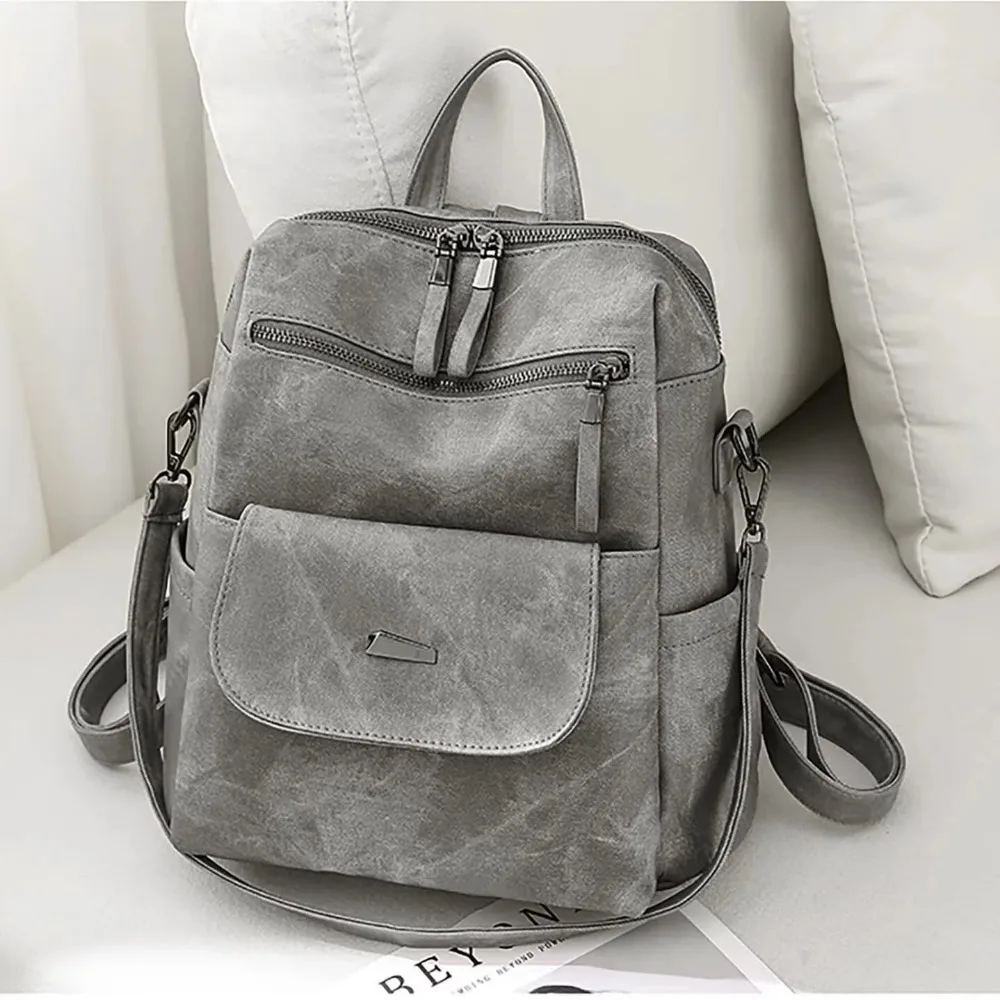
Silhouettes and Structural Design Elements
The silhouette of a leather backpack defines not only its visual appeal but also how it functions in daily use. Different structural designs serve distinct purposes while complementing various personal styles.
Common Backpack Silhouettes
Structured/boxy designs: These maintain their shape regardless of contents, offering excellent protection for laptops and documents. Their clean lines and architectural presence make them ideal for professional environments where presentation matters. These designs typically feature reinforced panels and may weigh slightly more than other options.
Slouchy/soft designs: With a more relaxed appearance, these backpacks conform to their contents and often feel lighter on the back. They offer a casual, effortless aesthetic while still providing functionality. These designs excel in versatility and comfort but may offer less protection for fragile items.
Minimal designs: Focused on streamlined essentials, these backpacks avoid excessive embellishments or complicated compartments. Their clean aesthetics make them timeless options that complement rather than dominate an outfit. They’re typically lightweight but may sacrifice some organizational features.
Statement designs: Distinguished by unique shapes, bold hardware, or distinctive details, these luxury leather backpacks make a fashion statement while still offering functionality. They’re ideal for those who view their backpack as an expression of personal style.
When considering structure, remember that it directly impacts capacity. Two backpacks with identical external dimensions can have dramatically different carrying capabilities based on their structural design. Stiffer constructions typically protect contents better but may feel more cumbersome, while softer designs offer flexibility but less protection.
Body proportions also play an important role in choosing the right silhouette. Oversized backpacks can overwhelm petite frames, while undersized options may look disproportionate on taller individuals. The best design balances visual harmony with your practical carrying needs.
Color Selection and Leather Finishes
Color choice significantly impacts both the versatility and maintenance requirements of your leather backpack. While personal preference should guide your selection, understanding the practical implications of different colors can help you make a more informed decision.
Classic Neutrals vs. Bold Statements
Black leather backpacks represent the ultimate in versatility, complementing virtually any outfit while showing minimal dirt or wear. They transition seamlessly between professional and casual environments, making them ideal for those seeking maximum utility from a single bag.
Brown leather backpacks offer warmth and character that develops beautifully over time. Available in various shades from cognac to chocolate, brown leather provides versatility while developing a richer patina than black leather typically does. Medium to darker browns strike an excellent balance between showing character and hiding wear.
Navy, tan, and burgundy offer sophisticated alternatives to black and brown while remaining relatively versatile. These colors can serve as neutrals while adding subtle distinction to your accessories.
Bold colors like red, green, or mustard yellow make more pronounced statements and can enliven otherwise simple outfits. While these require more careful outfit coordination, they can become signature pieces that express personal style.
Leather Finishes
The finish applied to leather dramatically affects both appearance and performance:
Smooth/polished finishes: Create a refined, elegant look that showcases the leather’s natural beauty. These finishes tend to show scratches more readily but can often be buffed out.
Pebbled/textured finishes: Feature a slightly bumpy surface that helps disguise minor scratches and wear. These finishes are generally more forgiving for everyday use.
Matte vs. glossy: Matte finishes offer understated sophistication and show fewer fingerprints, while glossy finishes provide more visual impact and sometimes better water resistance.
Distressed/vintage finishes: Pre-treated to appear slightly aged, these finishes embrace imperfections and additional marks as part of their character. They’re excellent options for those worried about maintaining a pristine appearance.
Remember that lighter colors will show dirt and stains more readily, requiring more frequent cleaning. However, darker colors can show dust and scratches more visibly. Your lifestyle and maintenance preferences should guide this important choice.
Hardware and Decorative Elements
Hardware serves both functional and aesthetic purposes, contributing significantly to a backpack’s character while enabling its practical features. Quality hardware can elevate a simple design, while poor hardware can undermine even the finest leather.
Types of Hardware and Their Impact
Zippers: The most frequently used component deserves careful consideration. Exposed metal zippers create industrial-chic contrast against leather, while hidden zippers offer a cleaner, more seamless look. YKK and other premium zipper brands provide smoother operation and greater longevity than generic alternatives.
Buckles and clasps: Beyond securing your belongings, these elements make a style statement. Magnetic closures offer convenient access but less security, while traditional buckles provide classic appeal and reliable closure. Look for solid metal construction rather than hollow or plated plastic.
Decorative elements: Studs, rivets, and ornamental hardware can transform a basic backpack into something distinctive. However, these elements should serve functional purposes where possible—decorative rivets that also reinforce stress points represent thoughtful design.
Protective hardware: Metal feet protect the bottom of structured backpacks from wear and dirty surfaces. This seemingly minor detail significantly extends a backpack’s lifespan.
The finish of your hardware—gold-tone, silver-tone, antique brass, or brushed nickel—should complement your leather color and personal accessories. Warmer leather tones typically pair beautifully with brass and gold finishes, while cooler tones harmonize with silver and nickel.
Hardware adds weight, so consider this practical aspect alongside aesthetics. A backpack with extensive metal embellishments may look stunning but become uncomfortable during extended wear. The best designs balance decorative elements with practical comfort.
Understanding different types of closures in leather backpacks helps you select features that match your accessibility preferences while complementing the overall design aesthetic.
Interior Organization and Compartments
The thoughtfully designed interior of a quality leather backpack transforms it from a simple carrying solution into an efficiency tool that streamlines your daily life. While external aesthetics might catch your eye first, interior organization often determines long-term satisfaction.
Essential Interior Features
Main compartment design: Some backpacks feature a single large compartment maximizing flexibility, while others incorporate dividers creating separate sections for better organization. Consider whether you prefer sorting items into distinct spaces or prefer the versatility of one adaptable area.
Laptop/device protection: Dedicated padded sleeves keep expensive electronics secure, ideally suspended slightly above the bottom to protect from impact when setting the bag down. Standard laptop sleeves accommodate 13-15 inch devices, but verify measurements for your specific needs.
Security pockets: Zippered interior pockets protect valuables like wallets and passports, ideally positioned against your back for additional theft protection. Some premium designs include RFID-blocking materials in these pockets to protect digital information.
Small item organization: Features like pen holders, card slots, and specific pockets for phones prevent smaller items from disappearing into the depths of your bag. These seemingly minor details significantly improve daily usability.
Key leashes: These simple straps attach to your keys, allowing quick access without digging through contents—a small feature that eliminates a common daily frustration.
Lining Considerations
Quality linings serve multiple purposes beyond aesthetics. Light-colored linings improve visibility of contents, while water-resistant options protect against spills. Premium backpacks often feature cotton canvas or microfiber rather than thin synthetic materials that can tear or separate from the leather exterior.
The best organizational designs balance structure with flexibility, providing dedicated spaces for common items while maintaining adaptability for changing needs. For strategies to maximize limited space, exploring guides on small leather backpack organization can provide valuable insights regardless of your backpack’s size.
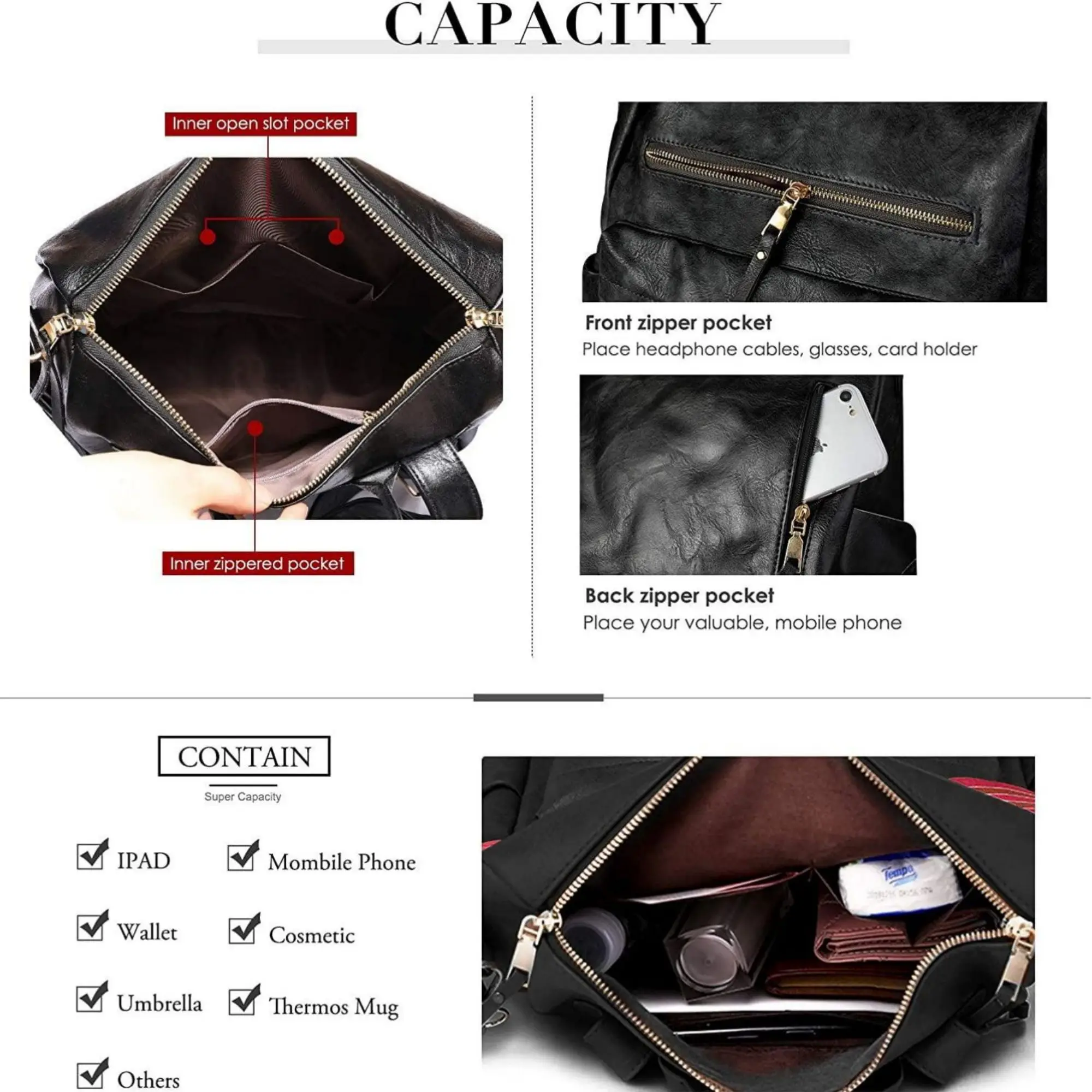
Exterior Pockets and Accessibility Features
While interior organization keeps items secure, exterior features determine how easily you can access frequently needed items. Thoughtfully designed exterior elements balance convenience, security, and aesthetic harmony.
Strategic Exterior Organization
Front pockets: These provide quick access to frequently used items without opening the main compartment. Magnetic closures offer one-handed operation, while zippered pockets provide better security. The ideal front pocket is large enough for a phone and small wallet but not so large that it disrupts the backpack’s clean lines.
Side pockets: Often designed for water bottles or umbrellas, these keep tall items accessible and prevent them from damaging other contents. Elastic or expandable side pockets accommodate various sizes while maintaining a streamlined appearance when empty.
Hidden security pockets: Discreet pockets positioned against your back or under flaps protect valuable items while maintaining the backpack’s aesthetic integrity. These features are particularly valuable for travel or crowded environments.
Trolley sleeves: These simple fabric panels allow the backpack to slide over suitcase handles, relieving shoulder strain during travel. This feature transforms a daily backpack into a practical travel companion without adding bulk.
Convertible leather backpacks often incorporate especially clever exterior features that facilitate their transformation between carrying styles. These adaptable designs maximize functionality while maintaining clean aesthetics.
The ideal exterior organization strikes a balance—too many external pockets can create a cluttered appearance and compromise security, while too few may force you to repeatedly open the main compartment for common items. Consider your daily habits and prioritize features that align with your specific needs.
Comfort Features and Ergonomic Design
Even the most beautiful leather backpack will remain unused if it causes discomfort. Thoughtful ergonomic design ensures your backpack works with your body rather than against it, especially important since leather typically weighs more than synthetic materials.
Critical Comfort Elements
Shoulder strap design: Quality leather backpacks feature wide straps (ideally 1-2 inches or 2.5-5 cm) that distribute weight across a larger area. Adequate padding prevents the straps from digging into shoulders, while proper attachment points position the backpack correctly against your back. Adjustability accommodates different body heights and seasonal clothing layers.
Back panel construction: The area that rests against your back significantly impacts comfort during extended wear. Light padding provides cushioning without excessive bulk, while strategically placed panels allow airflow to reduce heat buildup. Some designs incorporate ergonomic contours that follow the natural curve of the spine.
Weight distribution: Well-designed backpacks distribute contents evenly across your back rather than allowing weight to sag toward the bottom. This balanced approach reduces strain and improves posture during wear.
Top handles: Alternative carrying options provide relief when you don’t need hands-free convenience. Quality handles should be sturdy enough to support a fully loaded backpack without straining attachments.
Leather backpacks designed specifically for petite frames consider proportional sizing and strap placement to ensure comfort for smaller body types. These thoughtful adaptations demonstrate how ergonomic design must account for diverse user needs.
Remember that quality leather often requires a breaking-in period, during which straps and contact points will soften and conform to your body. Initial stiffness typically resolves within a few weeks of regular use, resulting in a backpack that feels custom-fitted to your frame.
Lifestyle-Specific Design Features
The ideal leather backpack complements your specific lifestyle needs. Understanding how design features align with different use cases helps you prioritize what matters most for your daily activities.
Professional and Work Environments
Women’s leather work backpacks prioritize sophisticated appearance and functional organization for professional settings. Key features include:
* Structured silhouettes that maintain a polished look even when fully loaded
* Padded laptop compartments with secure closures
* Document organizers that prevent paper folding or wrinkling
* Professional hardware that minimizes noise and flash
* Clean lines that complement business attire
These designs balance professionalism with practicality, allowing you to transition confidently between meetings while keeping essentials organized.
Travel Requirements
Women’s leather travel backpacks incorporate features that address the unique challenges of journeys:
* Anti-theft elements like hidden compartments and secure closures
* Trolley sleeves that slide over suitcase handles
* Expandable capacity to accommodate souvenirs
* Durable construction that withstands varied environments
* Comfort features that prevent fatigue during long days
The best travel designs maintain style while incorporating these practical elements, ensuring your backpack serves as both a functional travel companion and an attractive accessory.
Everyday Casual Use
Backpacks designed for daily casual use emphasize:
* Comfortable weight distribution for all-day wear
* Quick-access pockets for frequently used items
* Versatile styling that complements varied outfits
* Durable construction that withstands daily handling
* Manageable size that carries essentials without bulk
These everyday companions balance functionality with effortless style, seamlessly integrating into your daily routines.
Compact and Petite Options
Smaller backpacks designed for minimalist needs or petite frames feature:
* Proportional sizing that complements smaller body frames
* Lightweight construction that doesn’t overwhelm
* Strategic organization that maximizes limited space
* Versatile styling that works across multiple scenarios
The most versatile designs incorporate elements from multiple categories, allowing your backpack to adapt as your needs change throughout the week.
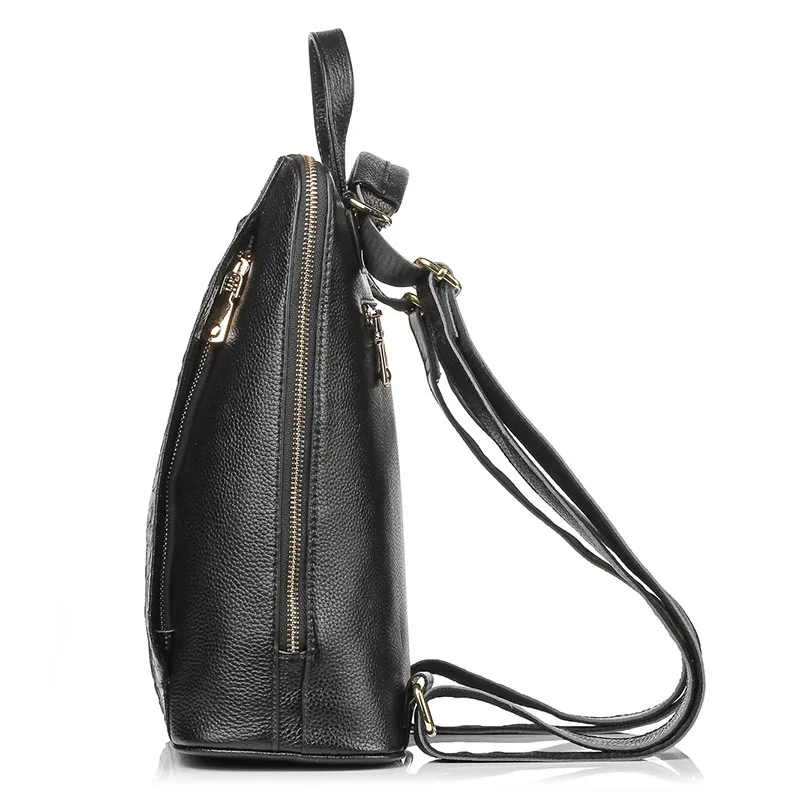
Convertibility and Versatility Features
Adaptable leather backpacks represent the pinnacle of functional design, transforming to meet changing needs throughout your day. These clever designs maximize value through their ability to serve multiple purposes.
Transformation Capabilities
Backpack to tote conversion: Designs with hideaway backpack straps and alternative carrying handles transform from hands-free backpacks to professional-looking totes in seconds. This versatility is particularly valuable when transitioning between casual commuting and formal professional environments.
Backpack to shoulder bag options: Convertible designs with detachable or repositionable straps allow you to switch carrying styles based on your outfit, comfort preferences, or the amount you’re carrying. This adaptability extends the backpack’s usefulness across more situations.
Expandable capacity: Clever designs featuring expansion zippers, adjustable closures, or modular attachments adapt to varying load requirements. These features allow your backpack to serve as both a sleek everyday companion and a more spacious weekend or travel bag when needed.
Modular components: Some premium designs include detachable pouches or wallets that function independently when you don’t need the entire backpack. These thoughtful additions extend versatility while maintaining design coherence.
Versatile compact leather bags for women demonstrate that even smaller designs can incorporate significant adaptability without sacrificing style or quality. The most successful convertible designs ensure that each configuration looks intentional rather than compromised.
When evaluating convertible features, consider conversion speed and ease—the best designs transform quickly without complex manipulations. Also assess whether hardware elements required for conversion add significant weight or disrupt the backpack’s aesthetic when not in use.
14 Inch Leather Laptop Backpack, Brown Leather Backpack, Men's Leather Backpack, Vintage Leather Backpack
Price range: $177.28 through $199.12 Select options This product has multiple variants. The options may be chosen on the product pageDesigner Mini Backpack, Mini Leather Backpack, Small Leather Sling Backpack, Women's Leather Backpack
Price range: $95.76 through $98.80 Select options This product has multiple variants. The options may be chosen on the product pageDesigner Mini Backpack, Designer Women's Backpack, Mini Leather Backpack, Women's Leather Backpack
Price range: $135.92 through $137.64 Select options This product has multiple variants. The options may be chosen on the product pageBlack Leather Backpack, Small Leather Backpack, Women's Leather Backpack
Price range: $112.96 through $116.12 Select options This product has multiple variants. The options may be chosen on the product pageBrown Leather Backpack, Women's Leather Backpack
$112.16 Select options This product has multiple variants. The options may be chosen on the product pageLuxury Leather Backpack, Small Leather Backpack, Women's Leather Backpack
Price range: $137.48 through $138.28 Select options This product has multiple variants. The options may be chosen on the product page
Care and Maintenance of Design Features
Proper maintenance ensures your leather backpack’s design features continue functioning beautifully for years. Different components require specific care approaches to maintain both appearance and functionality.
Caring for Different Elements
Leather maintenance: Regular cleaning with appropriate leather cleaners prevents dirt buildup, while conditioning 2-4 times yearly (depending on climate and use) restores moisture and prevents cracking. Different leather finishes may require specific products, so follow recommendations for your particular backpack.
Hardware care: Periodically wiping metal elements with a soft cloth prevents tarnishing and buildup of skin oils or environmental residues. For stubborn tarnish, a specialized metal cleaner appropriate for your hardware’s finish can restore shine without damaging the metal or adjacent leather.
Zipper longevity: Keeping zippers clean of dust and debris prevents mechanism failure. Occasionally running a graphite pencil along zipper teeth provides smooth operation without attracting dirt like oil-based lubricants do.
Interior maintenance: Regular emptying and gentle vacuuming removes debris that can abrade interior materials or transfer to carried items. For spot cleaning, follow material-appropriate guidelines without oversaturating the lining.
Proper storage significantly extends your backpack’s life. Store it stuffed with acid-free tissue to maintain shape, in a dust bag or pillowcase to prevent dust accumulation, and away from direct sunlight which can fade colors. Protecting your leather backpack from scratches during both use and storage preserves its appearance for years to come.
Consider seasonal deep-cleaning and conditioning rituals to address specific challenges like winter salt exposure or summer sweat accumulation. This proactive approach prevents minor issues from developing into significant damage.
How to Assess Quality When Shopping Online
Evaluating leather backpack quality without physical inspection presents unique challenges. However, strategic online shopping techniques can help you confidently identify superior products.
Online Quality Assessment Strategies
Photo analysis: Seek listings with multiple high-resolution images showing close-ups of stitching, hardware, interior features, and edge finishing. Quality brands proudly display these details rather than hiding them. Look for consistency in stitching and symmetrical construction.
Material specifications: Detailed descriptions should clearly state leather type (full-grain, top-grain, etc.) rather than vague terms like “genuine leather” or “PU leather.” Quality listings often explain tanning processes and hardware materials as well.
Weight information: Premium leather backpacks typically weigh more than synthetic alternatives or lower-quality leather. Product weights between 2-4 pounds (0.9-1.8 kg) often indicate substantial materials, though this varies by size and features.
Return policy evaluation: Confident manufacturers offer generous return windows and reasonable shipping terms, knowing their products withstand scrutiny upon arrival. Restrictive policies sometimes indicate awareness of potential quality issues.
Customer review assessment: Look beyond star ratings to read detailed reviews mentioning longevity, how the backpack ages, and how it handles daily use. Photos from actual customers often reveal true colors and how the backpack looks in natural lighting.
Red flags that may indicate quality concerns include: missing information about leather type, inconsistent stitching visible in photos, plastic hardware where metal would be appropriate, and vague descriptions that focus on style while avoiding construction details.
When uncertain, contact customer service with specific questions about construction methods or materials—quality brands typically provide knowledgeable, detailed responses.
FAQ: Common Questions About Leather Backpack Design Features
What’s the best leather type for daily use?
Full-grain leather offers the ideal balance of durability and character development for daily use. While it may show scratches more readily than processed leathers initially, these marks develop into a beautiful patina over time. If you prefer a more uniform appearance with good durability, top-grain leather provides an excellent alternative.
Are leather backpacks waterproof?
Leather backpacks are naturally water-resistant but not waterproof. Quality leather can handle light rain without immediate damage, especially when properly conditioned. However, prolonged exposure to heavy rain will eventually allow water penetration. Many premium backpacks incorporate water-resistant linings to protect contents even if the leather absorbs some moisture.
How heavy are leather backpacks compared to synthetic materials?
Leather backpacks typically weigh 1-2 pounds (0.45-0.9 kg) more than similar synthetic designs. A medium-sized leather backpack generally weighs 2-4 pounds (0.9-1.8 kg) empty, while comparable nylon or canvas options might weigh 1-2 pounds (0.45-0.9 kg). This additional weight represents the density and durability that make leather so long-lasting.
Will a leather backpack hold its shape over time?
Structured leather backpacks maintain their shape well with proper care and storage. Softer, unstructured designs will naturally conform to their contents and may develop a more relaxed appearance over time. Using a backpack organizer or stuffing with tissue paper during storage helps maintain the original shape.
How can I tell if hardware is high quality?
Quality hardware has substantial weight, smooth operation, and consistent finishing. Zippers should move smoothly without catching, while clasps and buckles should operate precisely without excess force. Metal hardware should feel cool to the touch rather than like lightweight metal-plated plastic.
Do leather backpacks work for travel?
Leather backpacks make excellent travel companions, particularly designs with security features, trolley sleeves, and thoughtful organization. Their durability withstands the rigors of travel, while their timeless style transitions seamlessly between different environments and occasions throughout your journey.
What’s the best way to break in stiff leather straps?
Gradually wearing your backpack with lighter loads initially helps straps conform naturally to your body shape. For particularly stiff straps, gently flexing them by hand and applying a light leather conditioner can accelerate the process. Avoid shortcuts like excessive bending or soaking, which can damage the leather structure.
How long should a quality leather backpack last?
With proper care, a high-quality full-grain leather backpack should last 10-15 years of regular use. Many premium backpacks become family heirlooms, developing character while maintaining functionality for decades. This exceptional longevity makes quality leather backpacks investments that offer excellent value despite higher initial costs.

